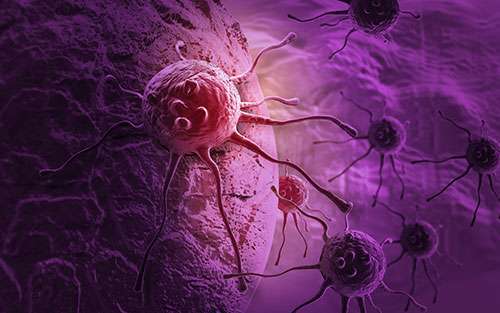
On This Page:
- Pancreatic Exocrine Tumors
- Pancreatic Neuroendocrine Tumors (PNETs)
- How Is the Type of Pancreatic Cancer Diagnosed?
Pancreatic tumors are either exocrine or neuroendocrine (endocrine) tumors. This is based on the type of cell they start in. Knowing the type of tumor is important because each type acts differently and responds to different treatments.
Within these types, each tumor’s biology is different. Biomarker testing gives patients information about their tumor’s biology.
Every pancreatic cancer patient is different. Patients who receive treatment based on their biology can live longer. The Pancreatic Cancer Action Network strongly recommends all pancreatic cancer patients get genetic testing for inherited mutations as soon as possible after diagnosis and biomarker testing of their tumor tissue to help determine the best treatment options.
Pancreatic Exocrine Tumors
About 93 percent of pancreatic cancers are exocrine tumors. They start in the exocrine cells of the pancreas, which produce enzymes that help with digestion.
Adenocarcinoma
The most common type of pancreatic cancer is adenocarcinoma. About 9 out of 10 people with pancreatic cancer have this type of cancer.
Adenocarcinoma is an exocrine tumor. It starts in the cells lining the pancreatic duct, which make enzymes for digestion.
The word “adenocarcinoma” alone can apply to cancer of other organs. But, if the cancer started in the pancreas, it is pancreatic adenocarcinoma. Learn more about:
Other Exocrine Tumors
Acinar cell carcinoma is a very rare form of pancreatic cancer. Some tumors may cause the pancreas to make too much lipase, an enzyme that digests fats. Pancreatic lipase levels can be measured in the blood.
An intraductal papillary-mucinous neoplasm (IPMN) is a tumor that grows from the main pancreatic duct or from side branches of the duct. An IPMN may be benign (not cancer) when diagnosed. But, it has a chance of becoming cancer. This risk is high when the IPMN starts in the main pancreatic duct.
Mucinous cystic neoplasm with an invasive adenocarcinoma is a rare, cancerous tumor. It is a cyst filled with thick fluid. It is like an IPMN but is in just one part of the pancreas, usually the tail. These tumors are mostly in women. Mucinous cystic neoplasms can be benign (not cancer) if there is no invasive component.
There are other rare exocrine tumor types. For more information about any type of pancreatic cancer, contact PanCAN Patient Services.
Pancreatic Neuroendocrine Tumors (PNETs)
About 7 percent of pancreatic tumors are neuroendocrine tumors (pancreatic NETs or PNETs), also called islet cell tumors. They often grow slower than exocrine tumors.
PNETs come from the abnormal growth of endocrine cells in the pancreas called islet cells. These cells make hormones to control blood-sugar levels.
Pancreatic neuroendocrine tumors are either functional (produce hormones) or nonfunctional (do not produce hormones). Most PNETs are nonfunctional.
Pancreatic endocrine tumors have different symptoms, act differently and respond to different treatments than the more common pancreatic exocrine tumors.
PNETs are classified by the hormones they make. Common PNET types are:
- Gastrinoma (gastrin)
- Glucaganoma (glucagon)
- Insulinoma (insulin)
- Somatostatinoma (somatostatin)
- VIPoma (vasoactive intestinal peptide)
- Nonfunctional Islet Cell Tumor (no hormones)
Learn more about pancreatic neuroendocrine tumors.
How Is the Type of Pancreatic Cancer Diagnosed?
Imaging tests are important in diagnosing pancreatic cancer. But, to get an exact diagnosis, the doctor needs a tissue sample, or biopsy, of the tumor.
A pathologist looks at tissue samples under a microscope. The shape, size and arrangement of the cancer cells may help the pathologist figure out the type of pancreatic cancer.
Learn more about pancreatic cancer diagnosis.
We’re Here to Help
For free, in-depth and personalized resources and information on pancreatic cancer, contact PanCAN Patient Services.
Related Topics
-
Diagnosis
See how pancreatic cancer is found, including tests used.
-
Pancreatic Neuroendocrine Tumors (PNETs)
Learn more about this rare tumor type, including symptoms and treatment.
-
Treatment Types
Learn about the treatments available for the most common type of pancreatic cancer.
Information reviewed by PanCAN’s Scientific and Medical Advisory Board, who are experts in the field from such institutions as University of Pennsylvania, Memorial Sloan-Kettering Cancer Center, Virginia Mason Medical Center and more.
Information provided by the Pancreatic Cancer Action Network, Inc. (“PanCAN”) is not a substitute for medical advice, diagnosis, treatment or other health care services. PanCAN may provide information to you about physicians, products, services, clinical trials or treatments related to pancreatic cancer, but PanCAN does not recommend nor endorse any particular health care resource. In addition, please note any personal information you provide to PanCAN’s staff during telephone and/or email communications may be stored and used to help PanCAN achieve its mission of assisting patients with, and finding cures and treatments for, pancreatic cancer. Stored constituent information may be used to inform PanCAN programs and activities. Information also may be provided in aggregate or limited formats to third parties to guide future pancreatic cancer research and education efforts. PanCAN will not provide personal directly identifying information (such as your name or contact information) to such third parties without your prior written consent unless required or permitted by law to do so. For more information on how we may use your information, you can find our privacy policy on our website at https://www.pancan.org/privacy/.





